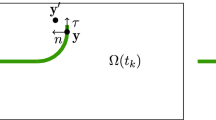Abstract
A new direct-integration technique for the virtual crack extension method which employs variational theory in the finite element formulation is presented. Similar techniques to derive explicit integral forms of the energy release rate have been introduced by deLorenzi [1] and Haber and Koh [2]; however, the formulation proposed here not only provides accurate results but also is simpler and more general than the earlier forms. Moreover, this method can be extended to derive higher order derivatives of the energy release rate, e.g., the rates of the energy release rate for mixed-mode fracture. With Betti's theorem and the mutual energy concept [3], a simple but effective uncoupling technique for mixed-mode stress intensity factors is also possible. Combined with the higher order derivatives of the energy release rate, this uncoupling technique can be used to derive the first derivatives of the stress intensity factors which in turn can be employed for better prediction of crack stability and rate of propagation.
Résumé
On présente une nouvelle technique par intégration directe relative à la méthode d'extension virtuelle d'une fissure, qui recourt à une approche par variations de la formulation des éléments finis. Delorenzi, et Haber et Koh, ont déjà présenté des techniques similaires en vue de déduire la vitesse de relaxation de l'énergie sous forme d'intégrales explicites. Toutefois, la formulation présentée ici non seulement procure des résultats exacts, mais en outre est d'un usage plus simple et plus général que les précédentes. En outre, la méthode permet une extension pour déduire des dérivées d'ordre supérieur de la vitesse de relaxation de l'énergie, notamment les vitesses relatives à des ruptures de mode mixte. En recourant au théorème de Batti et au concept d'énergie mutuelle, il est également possible d'appliquer une technique de découplage effectif pour des facteurs d'intensité de contraintes relatifs à un mode mixte. Combiné aux dérivées d'ordre supérieur pour la vitesse de relaxation de l'énergie, cette technique de découplage peut être employée pour déduire les dérivées premières des facteurs d'intensité de contraintes, lesquelles peuvent être à leur tour utilisées à une meilleure prédiction de la stabilité d'une fissure et de sa vitesse de propagation.
Similar content being viewed by others
References
H.G. deLorenzi, Engineering Fracture Mechanics 21 (1985) 129–143.
R.B. Haber and H.M. Koh, International Journal for Numerical Methods in Engineering 21 (1985) 301–315.
J.F. Yau, S.S. Wang, and H.T. Corten, Journal of Applied Mechanics 47 (1980) 335–341.
J.R. Dixon and L.P. Pook, Nature 224 (1969) 166–167.
V.B. WatwoodJr., Nuclear Engineering and Design 11 (1969) 323–332.
T.K. Hellen, “The Finite Element Calculations of Stress Intensity Factors Using Energy Techniques”, 2nd International Conference on Structural Mechanics in Reactor Technology, Paper G5/3, Berlin, Germany 1973.
T.K. Hellen and W.S. Blackburn, International Journal of Fracture 11 (1975) 605–617.
T.K. Hellen, International Journal for Numerical Methods in Engineering 9 (1975) 187–207.
D.M. Parks, International Journal of Fracture 10 (1974) 487–502.
D.M. Parks, in Proceedings of the 1st International Conference on Numerical Methods in Fracture Mechanics (1978) 464–486.
M.L. Vanderglas, International Journal of Fracture 14 (1978) R291-R293.
G.T. Sha, Engineering Fracture Mechanics 19 (1984) 685–699.
R.M. WalshJr. and R.B. Pipes, Engineering Fracture Mechanics 22 (1985) 17–33.
L. Banks-Sills and D. Sherman, International Journal of Fracture 32 (1986) 127–140.
H. Ishikawa, International Journal of Fracture 16 (1980) 243–246.
H. Ishikawa, H. Kitagawa, and H. Okamura, in 3rd International Conference on Mechanical Behaviour of Materials, Cambridge, England (1979) 447–455.
M.L. Vanderglas and R.J. Pick, in Fracture, 3, 4th International Conference on Fracture, Waterloo, Canada (1977) 501–506.
G.T. Sha and C.-T. Yang, Engineering Fracture Mechanics 21 (1985) 1119–1149.
M. Stern, E.B. Becker, and R.S. Dunham, International Journal of Fracture 12 (1976) 359–368.
W.K. Wilson, “Combined-Mode Fracture Mechanics”, Ph.D. dissertation, University of Pittsburgh (1969).
H. Tada, P. Paris, and G. Irwin, The Stress Analysis of Cracks Handbook, Del Research Corporation, Hellertown, Pennsylvania (1973).
S.C. Lin, “Numerical Simulation of Through-crack Propagation in General Shells by Energy Integrations” Ph.D. dissertation, Cornell University (1988).
Author information
Authors and Affiliations
Rights and permissions
About this article
Cite this article
Lin, SC., Abel, J.F. Variational approach for a new direct-integration form of the virtual crack extension method. Int J Fract 38, 217–235 (1988). https://doi.org/10.1007/BF00034286
Received:
Accepted:
Issue Date:
DOI: https://doi.org/10.1007/BF00034286



